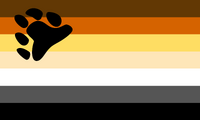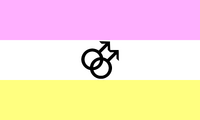| Please take note: | |
| This article is a work in progress and is currently incomplete. Additional content will be added as it is written and sourced. |
- This article is about men who are gay. For any person attracted to their own gender, see Gay.
Gay men are men with an enduring physical, romantic, and/or emotional attraction to other men.[1] This article is separated from that of the umbrella term gay to focus specifically on this sexual orientation.
Etymology
The term "uranian" was once used to describe gay men. It was coined by Karl Heinrich Ulrichs, who used the term in this context in his collection, Forschungen über das Räthsel der mannmännlichen Liebe. However, uranian became associated with paederastic poetry between the 1870s and 1930s, with "paederastic" meaning "relationships between adult men and pubescent or adolescent boys". Uranian is now considered a problematic term for gay man.[2]
By the 1960s, gay men had taken to the term to refer to their own sexual identity, and by today's standards, it is the acceptable way to refer to homosexual men.[3]
Vincian is a more modern alternative term for gay men. The term itself is named after Leonardo Da Vinci, and is intended to be a gay man equivalent to lesbian. It has been used with this definition since at least June 27th, 2021.[4]
Community
Gay men were specifically targeted by the Nazis. At certain concentration camps, gay men had a downward-pointing pink triangle sewn onto their shirts. It was not until the 1970s that the symbol was reclaimed as a symbol of gay pride.[5]
Studies at Johns Hopkins reveal that gay men relationships are just as likely to face domestic abuse as straight relationships. The same factors of manipulation and control exist in domestic violence. However, a key difference is that in gay men relationships, there is a threatening to “out” the victim to their family, friends and co-workers and the victim will not seek help because they fear revealing their sexual orientation to others will put them in even greater danger with their partner.[6]
Gay subcultures
Bears
- Main article: Bear

The bear flag
One of the many gay subcultures, a "bear" is generally speaking a large-build, hairy man over 30 years old. Hunky, chunky, often with bellies, big legs, big butts, and almost always with a full beard or facial hair, "bears" are often attributed the general stereotype of "traditional masculinity", a notion that is strengthened by some bear clubs and bars not being open to women, twinks, transgender people, etc. However, being a bear is about appearance and has thus nothing to do with identity and mannerisms.[7]
Twinks
- Main article: Twink

A proposed twink flag
As with all identities, the definition depends on the person asked, but broadly stated, a "twink" can be defined as a thin, smaller-built, and pretty smooth person with little to no body hair[8] and usually someone in their late teens-early twenties[9] or someone who looks younger than their age.[10] Due to their build, twinks are often wrongfully assumed to be camp and effeminate, shy and insecure, and clueless when it comes to sexual acts. This often leads to a hypersexualization of people fitting the mold and a problematic media representation as playthings and not-to-be-taken-serious sexual objects.[8]
Flag
The modern gay men's pride flag was posted in 2019 on the Tumblr blog gayflagblog as an update of a prior gay men flag. It features an array of green, blue, and purple shades to be representative of a wide range of gay men, regardless of their gender, thus also including, but not being limited to, gay men who are transgender, non-binary, gender non-conforming, aromantic, or asexual. This version replaced the original one that only used blue tones, as it was regarded as a stereotypical representation of the gender binary and lacked meaning for the colors used. Inspired by Gilbert Baker and the responses to the blue flag, the individual stripes used by gayflagblog mean:[11]
- Green: Community[11]
- Teal: Healing[11]
- Light teal/green: Joy[11]
- White: Gender non-conforming, non-binary, and trans men[11]
- Light blue: Pure love[11]
- Purple: Fortitude[11]
- Indigo: Diversity[11]
The combination of green and teal also represents nature, in defiance of the perception of love between men as "unnatural". Green also draws upon the use of green plants and flowers, specifically carnations and hyacinths. The use of white was derived from the Trans Pride Flag to explicitly represent identities that are often erased and the need to address and resolve transphobia, internalized homophobia, and toxic masculinity. The light blue leading into purple was inspired by criticism of the blue flag ("oh blue for boy? bleh") and symbolizes how gay men may or may not be stereotypical, in-between, or fluid. The purple and indigo together represent diversity in presentation, relationships, and life experience; not fitting into neat categories, "especially by those who choose to fetishize us & by non-MLM, but in reality there are so so many different ways to be a man and so many ways to be a man who loves or who is in a relationship with other men, and this needs to be emphasized".[11]
Media
Film
Television
- Wylan Hendricks from Shadow and Bone[13]
- Oscar Martinez from The Office[14]
- Alec Lightwood from Shadowhunters[15]
- Ham Tobin from The Great North
- Ian Gallagher and Mickey Milkovich from Shameless[16]
- Jude Adams Foster and Connor Stevens from The Fosters[17]
- Kurt Hummel and Blaine Anderson from Glee[18]
Music
- Darren Hayes (Savage Garden)[19]
Video games
- Soldier: 76 in Overwatch[20]
